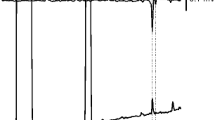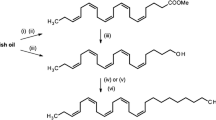Abstract
Bioassay studies with mixtures of the two components from the sex pheromone ofE. postvittana are used to construct a dose-response surface. The surface clearly shows the existence of a response maximum and that an optimum ratio of the two components applies over a wide range of concentrations. Probit transformations of the same data are used to construct an isobologram. The isobole has a sharp minimum at a ratio for the two components close to the ratio produced by the females.
Similar content being viewed by others
References
Akima, H. 1973. A method of bivariate interpolation and smooth surface fitting based on local procedures. U.S. Department of Commerce, Office of Telecommunications, OT Report 73–7.
Bake, T.C., Meyer, W., andRoelofs, W.L. 1981. Sex pheromone dosage and blend specificity of response by oriental fruit moth males.Entomol. Exp. App. 30:269–279.
Bartell, R.J., andLawrence, L.A. 1973. Reduction in responsiveness of males ofEpiphyas postvittana (Lepidoptera) to sex pheromone following previous brief pheromonal exposure.J. Insect Physiol. 19:845–855.
Bartell, R.J., andLawrence, L.A. 1977. Reduction in responsiveness of male light-brown apple moths,Epiphyas postvittana, to sex pheromone following pulsed pre-exposure to pheromone components.Physiol. Entomol. 2:89–95.
Bartell, R.J., andRoelofs, W.L. 1973. Evidence for natural secondary compounds which modify the response of males of the redbanded leafroller to female sex pheromone.Ann. Entomol. Soc. Am. 66:481–483.
Bartell, R.J., andShorey, H.H. 1969. A quantitative bioassay for the sex pheromone ofEpiphyas postvittana (Lepidoptera) and factors limiting male responsiveness.J. Insect Physiol. 15:33–40.
Bellas, T.E., Bartell, R.J., andHill, A. 1983. Identification of the sex pheromone of the moth,Epiphyas postvittana (Lepidoptera, Tortricidae).J. Chem. Ecol. 9:503–512.
Cardé, R.T., Cardé, A.M., Hill, A.S., andRoelofs, W.L. 1977. Sex pheromone specificity as a reproductive isolating mechanism among the sibling speciesArchips argyrospilus andA. mortuanus and other sympatric Tortricine moths (Lepidoptera: Tortricidae).J. Chem. Ecol. 3:71–84.
Finney, D.J. 1971.In Probit Analysis. Cambridge University Press, Cambridge.
Geier, P.W., andSprinoett, B.P. 1976. Population characteristics of Australian leafrollers (Epiphyas spp., Lepidoptera) infesting orchards.Aust. J. Ecol. 1:129–144.
Hewlett, P.S. 1969. Measurement of the potencies of drug mixtures.Biometrics 25:477–487.
Loewe, S., andMuischnek, H. 1926. Über Kombinationswirkungen.Naunyn-Schmiedeberg's Arch. Pharmacol. 114:313–326.
Miller, J.R., andRoelofs, W.L. 1980. Individual variation in sex pheromone component ratios in two populations of the redbanded leafroller moth,Argyrotaenia velutinana.Environ. Entomol. 9:359–363.
Miller, J.R., Baker, T.C., Cardé, R.T., andRoelofs, W.L. 1976. Reinvestigation of the oak leaf roller sex pheromone components and the hypothesis that they vary with diet.Science 192:140–143.
Morse, P.M. 1978. Some comments on the assessment of joint action in herbicide mixtures.Weed Sci. 26:58–71.
Persoons, C.J., Voerman, S., Verwiel, P.E.J., Ritter, F.J., Nooyen, W.J., andMinks, A.K. 1976. Sex pheromone of the potato tuberworm moth,Phthorimaea operculella: Isolation, identification and field evaluation.Entomol. Exp. Appl. 20:289–300.
Roelofs, W.L. 1978. Threshold hypothesis for pheromone perception.J. Chem. Ecol. 4:685–699.
Roelofs, W. 1979. Production and perception of lepidopterous pheromone blends, pp. 159–168.in R.J. Ritter (ed.). Chemical Ecology: Odour Communication in Animals. Elsevier/ North Holland Biomedical Press, Amsterdam.
Tamaki, Y. 1977. Complexity, diversity, and specificity of behavior-modifying chemicals in Lepidoptera and Diptera, pp. 253–285.in H.H. Shorey and J.J. McElvey, Jr. (eds). Chemical Control of Insect Behavior. Wiley, New York.
Tammes, P.M.L. 1964. Isoboles, a graphic representation of synergism in pesticides.Neth. J. Plant Pathol. 70:73–80.
Author information
Authors and Affiliations
Rights and permissions
About this article
Cite this article
Bellas, T.E., Bartell, R.J. Dose-response relationship for two components of the sex pheromone of lightbrown apple moth,Epiphyas postvittana (Lepidoptera: Tortricidae). J Chem Ecol 9, 715–725 (1983). https://doi.org/10.1007/BF00988778
Received:
Revised:
Issue Date:
DOI: https://doi.org/10.1007/BF00988778




